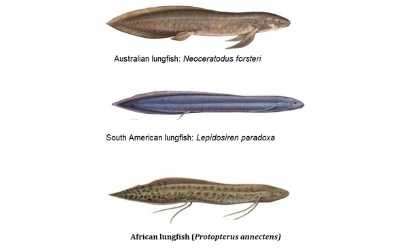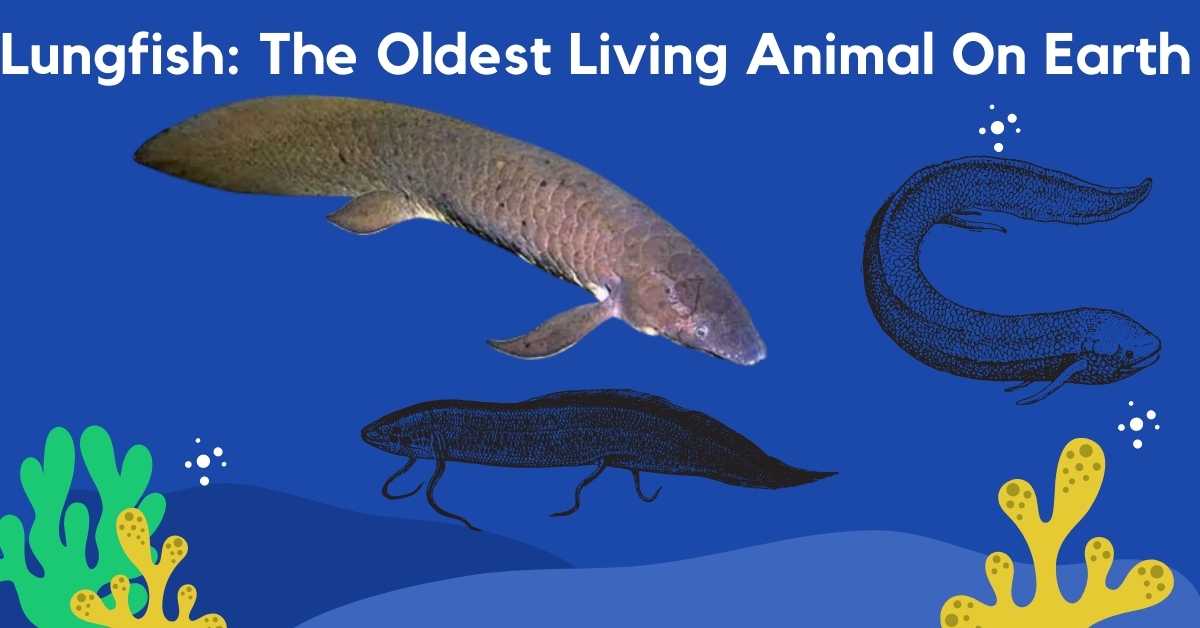The lungfish is the oldest living animal on earth. It lives in muddy waters in Africa, South America, and Australia. What seems most surprising about these creatures is that they can survive without breathing air. They have developed the ability to respire through their skin, mouth, and gills. These fish can live without oxygen for up to four days, which is something humans cannot do. Find out more about this interesting creature here!
The History
Lungfish are the only living lineage of the class Sarcopterygii, which is a subclass that existed with amphibians in the Devonian period. This means that lungfish were present before there were any land-dwelling vertebrates.
Lungfish are heavily armored, so they are more closely related to some extinct armored fish than to any other living fish. The first fossils of lungfish come from about 400 million years ago, so it has been on earth for a very long time.
You might also read: Phylogeny of Fishes
It is a very primitive fish, and it shares a lot of traits with amphibians. When it is old, it will develop a lung to breathe air. It can also crawl on land for short distances.
Lungfish live in the water and on land, but they mostly live in areas where they can go back and forth between land and water. These are called tidal zones, which are the areas where the tide goes back and forth every day. They have also been found in streams, lakes, and ponds.
A lungfish’s life starts as a larva in a big egg, and they eat a lot of plant matter until they become adults. They will eat anything they can find.
What is a lungfish?
Lungfish are freshwater fish that can be found in Africa, South America, and Australia. They are called lungfish because they can breathe through their lungs, their gills, and their skin. They are the oldest living animal on earth, living for over 300 million years. A lungfish can survive without air for 4-5 days, which is something humans cannot do. Lungfish live in muddy waters that are warm and shallow.
Lungfish was once thought to be extinct until they were rediscovered in the 1880’s in Africa. They are interesting creatures that still have many mysteries to be solved about them.
Types of Lungfish
There are three types of lungfish: the African lungfish (Protopterus annectens), South American lungfish (Lepidosiren paradoxa), and the Australian lungfish (Neoceratodus forsteri). The African lungfish lives in Southern Africa, while the Australian lungfish live in Australia. Among them, African lungfish and Australian lungfish are very similar but have some key differences.
The African lungfish spends its days in the water, while the Australian lungfish spends its days on land. Both of these animals have developed gills that allow them to breathe in water, but they have also developed lungs that allow them to breathe in air.
The African lungfish is an invasive species in Australia, which means it can be found there despite not being native to that region. The Australian lungfish come out of the water for short periods of time but can live on land for many years at a time.

Size Range and Distribution of Lungfish
Lungfish are found in Africa, South America, and Australia except for Antarctica. They can be found in a variety of habitats, from the African savannah to Siberian wetlands. The largest lungfish is about six feet long and can weigh as much as 44 pounds. The smallest lungfish is only four inches long and weighs as little as one ounce. These fish have been around for a long time, so they have adapted to a variety of habitats and climates.
Lungfish are unique because they breathe air and can survive in water with low oxygen levels. They also have a vascular lung, which allows them to breathe air and extract oxygen from it. They are the only living lineage of animals with amphibian traits, and they’re unique because they breathe air and can survive with low oxygen levels.
Where Lungfish Lives
Lungfish can be found in freshwater, and they inhabit a variety of earth’s environments. In the past, lungfish were primarily found in the African region. However, now they have been widely introduced to other regions around the world.
They have traditionally been found in places including Australia, Laos, and Bolivia. They have also been introduced to other regions including Europe and North America.
They are mostly found near the water’s edge, as they have adapted to live in brackish estuaries and freshwater lakes as well as swamps and mangrove forests. They also live in the mouths of rivers as well as the coastlines of estuaries and bays. In addition, lungfish can be found living at high altitudes and high latitudes, even though their natural habitat is near the water.
What Lungfish Eats
Lungfish are not fussy eaters! They will eat whatever is available to them. These fish usually eat small invertebrates like worms and insects. They also eat plant detritus, zooplankton, or anything that is small enough for them to swallow.
They hunt for these prey hiding in the bottom of ponds and shallow wetlands. They use their sensitive barbels to feel the vibrations of their prey in the mud. Lungfish also use their barbels to find food in the dark.
These fish can survive in water that contains very little oxygen. They consume the food in the mud and breathe through their skin, mouth, and gills.
Reproduction and Life Cycle of Lungfish
Lungfish reproduce by laying eggs. The larvae go through a leptocephalus larva stage before they develop into fully grown fish. Lungfish can live to be over 60 years old in captivity. They have a very slow metabolism and low heart rate, so they’re very calm fish.
They are slow-moving fish that is primarily found in freshwater lakes and swamps. They are omnivores and feed on anything they can find, but mainly on bottom-dwelling invertebrates like worms and shrimps. They use their fins to walk on the bottom of the water and push themselves forward, or they use their pectoral fins to swim. They lie partially buried in the mud and wait for prey to pass by before striking.
Who are the lungfish’s predators?
One of the lungfish’s predators is the Tassie devil. They are carnivorous marsupials found in Tasmania, Australia. A Tassie devil has a long snout and a body with stripes. A Tassie devil hunts by sitting and waiting for prey to come close. They then pounce and grab their prey, which is usually a smaller animal.
The lungfish’s other predators are humans and other animals that live near rivers and lakes. As the lungfish is not a strong swimmer, it is not able to escape from these predators. The lungfish’s defenses are its thick skin and sharp teeth.
Some animals prey on the lungfish by digging them up from their burrows. They can escape by releasing sand and mud from their burrow to cover themselves and escape their predator’s hunting grounds.
How do they survive without air?
The lungfish is the oldest living animal on earth. It has a long lifespan and a very complicated reproductive system. They have primitive lung, which allows them to breathe air, but they can also breathe through their skin, mouth, and gills.
It can live without oxygen for up to four days, something humans cannot do. They have developed the ability to respire through their skin, mouth, and gills.
Why is this important to know about?
The lungfish is a very interesting creature. It is the oldest living animal in the world and has been around for over 300 million years. It lives in muddy waters in Africa, South America, and Australia.
The most surprising thing about this animal is that it doesn’t need to breathe air to survive. In fact, it can go for four days without breathing any oxygen at all. Humans cannot survive for more than a few minutes without air.
It is an interesting creature to know about because it has been around for so long. It has been able to develop this ability to survive without breathing air for so long because of its evolution.
Economic Importune
Lungfish are of economic importance to some countries, like Ghana, where they are harvested for their meat. Lungfish meat is also important to the diet of some people in Africa, the Americas, and Australia.
The harvest of lungfish is not regulated because it is not of economic importance to most countries.
You might also read: Aquatic Adaptation of Mammals
Conclusion
The lungfish is one of the most ancient animals on earth. It has been present since the Devonian period and is the only living lineage of the class Sarcopterygii. It is also closely related to extinct armored fish than to any other living fish. These fish can live without oxygen for up to four days. The lungfish is a creature that has been able to adapt to its surroundings in order to survive.

